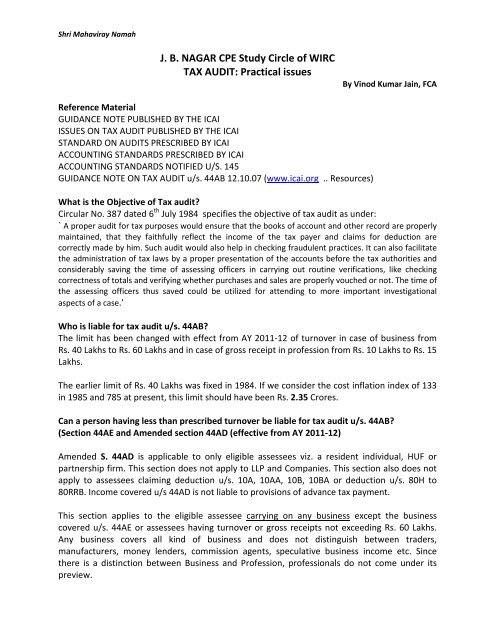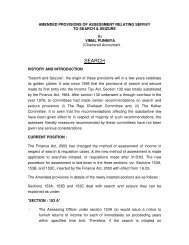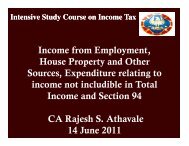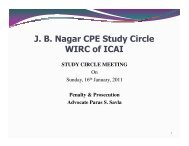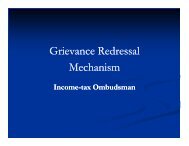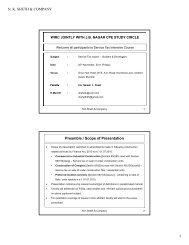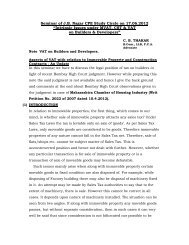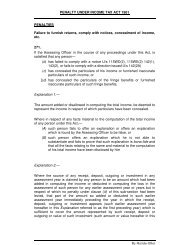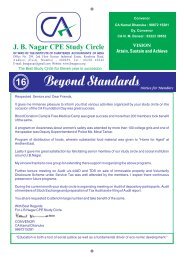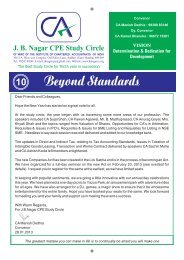J. B. NAGAR CPE Study Circle of WIRC TAX AUDIT: Practical issues
J. B. NAGAR CPE Study Circle of WIRC TAX AUDIT: Practical issues
J. B. NAGAR CPE Study Circle of WIRC TAX AUDIT: Practical issues
You also want an ePaper? Increase the reach of your titles
YUMPU automatically turns print PDFs into web optimized ePapers that Google loves.
Shri Mahaviray NamahJ. B. <strong>NAGAR</strong> <strong>CPE</strong> <strong>Study</strong> <strong>Circle</strong> <strong>of</strong> <strong>WIRC</strong><strong>TAX</strong> <strong>AUDIT</strong>: <strong>Practical</strong> <strong>issues</strong>By Vinod Kumar Jain, FCAReference MaterialGUIDANCE NOTE PUBLISHED BY THE ICAIISSUES ON <strong>TAX</strong> <strong>AUDIT</strong> PUBLISHED BY THE ICAISTANDARD ON <strong>AUDIT</strong>S PRESCRIBED BY ICAIACCOUNTING STANDARDS PRESCRIBED BY ICAIACCOUNTING STANDARDS NOTIFIED U/S. 145GUIDANCE NOTE ON <strong>TAX</strong> <strong>AUDIT</strong> u/s. 44AB 12.10.07 (www.icai.org .. Resources)What is the Objective <strong>of</strong> Tax audit?Circular No. 387 dated 6 th July 1984 specifies the objective <strong>of</strong> tax audit as under:` A proper audit for tax purposes would ensure that the books <strong>of</strong> account and other record are properlymaintained, that they faithfully reflect the income <strong>of</strong> the tax payer and claims for deduction arecorrectly made by him. Such audit would also help in checking fraudulent practices. It can also facilitatethe administration <strong>of</strong> tax laws by a proper presentation <strong>of</strong> the accounts before the tax authorities andconsiderably saving the time <strong>of</strong> assessing <strong>of</strong>ficers in carrying out routine verifications, like checkingcorrectness <strong>of</strong> totals and verifying whether purchases and sales are properly vouched or not. The time <strong>of</strong>the assessing <strong>of</strong>ficers thus saved could be utilized for attending to more important investigationalaspects <strong>of</strong> a case.’Who is liable for tax audit u/s. 44AB?The limit has been changed with effect from AY 2011-12 <strong>of</strong> turnover in case <strong>of</strong> business fromRs. 40 Lakhs to Rs. 60 Lakhs and in case <strong>of</strong> gross receipt in pr<strong>of</strong>ession from Rs. 10 Lakhs to Rs. 15Lakhs.The earlier limit <strong>of</strong> Rs. 40 Lakhs was fixed in 1984. If we consider the cost inflation index <strong>of</strong> 133in 1985 and 785 at present, this limit should have been Rs. 2.35 Crores.Can a person having less than prescribed turnover be liable for tax audit u/s. 44AB?(Section 44AE and Amended section 44AD (effective from AY 2011-12)Amended S. 44AD is applicable to only eligible assessees viz. a resident individual, HUF orpartnership firm. This section does not apply to LLP and Companies. This section also does notapply to assessees claiming deduction u/s. 10A, 10AA, 10B, 10BA or deduction u/s. 80H to80RRB. Income covered u/s 44AD is not liable to provisions <strong>of</strong> advance tax payment.This section applies to the eligible assessee carrying on any business except the businesscovered u/s. 44AE or assessees having turnover or gross receipts not exceeding Rs. 60 Lakhs.Any business covers all kind <strong>of</strong> business and does not distinguish between traders,manufacturers, money lenders, commission agents, speculative business income etc. Sincethere is a distinction between Business and Pr<strong>of</strong>ession, pr<strong>of</strong>essionals do not come under itspreview.
2It prescribes 8% <strong>of</strong> turnover or gross receipts as net pr<strong>of</strong>it from the business, or at a sum higherthan aforesaid as declared in the return as income chargeable to income. In case an eligibleassessee chooses to <strong>of</strong>fer income lower than what is prescribed, then, the assessee is requiredto maintain books <strong>of</strong> account and get them audited u/s. 44AB.Similarly S. 44AE provides assessee owning less than 10 carriages and earning from business <strong>of</strong>plying, hiring or leasing goods carriages will have presumptive income from heavy goodsvehicles Rs. 5,000 per vehicle per month and from light goods vehicle Rs. 4,500 per vehicle permonth. If such assessee chooses to <strong>of</strong>fer income lower than what is prescribed, then, theassessee is required to maintain books <strong>of</strong> account and get them audited u/s. 44AB <strong>of</strong> the Act.Who can be appointed as Tax AuditorA Chartered Accountant or a firm <strong>of</strong> Chartered Accountants in full time practice can beappointed as Tax Auditor. Internal Auditor cannot be a tax auditor. (wef 12.12.08)Communication with previous auditor, whether necessary?Yes. What, if previous auditor objects on outstanding consultancy fees?How many Tax Audits a Chartered Accountant can undertake?A firm <strong>of</strong> Chartered Accountants cannot accept more than 45 Tax Audits per partner. A membercannot accept more than 45 tax audits.How can a Company remove Tax Auditor?Removal <strong>of</strong> tax auditor does not require compliance as specified u/s. 224 <strong>of</strong> Companies Act.There is no specific procedure, however, it is possible for the management to remove a taxauditor when there are valid grounds for such removal.Is it mandatory to submit to tax audit report to AO after efilling returnAnnexure less return. Under rule 12(2) the report etc. should not be furnished along withreturn <strong>of</strong> income. Tax Audit report may be retained by the assessee in his records and producedto AO whenever called for during hearings. However, filling up particulars <strong>of</strong> tax audit in theereturn is important and date <strong>of</strong> <strong>of</strong> audit mentioned therein is also significant.Consequence <strong>of</strong> failure to carry out tax audit in time (S. 271B)If an assessee fails to procure tax audit reprot within prescribed time AO can levy penalty <strong>of</strong> anamount being lower <strong>of</strong> ½% <strong>of</strong> Turnover or gross receipts or Rs. 1,50,000/- (wef 1.4.11, earlierRs. 1,00,000/-). However if failure is for reasonable cause penalty is not to be levied. S.273BCan penalty u/s. 271B be imposed when books <strong>of</strong> account not maintained?Assessee not maintaining books <strong>of</strong> account, penalty can be levied only u/s. 271A for violation <strong>of</strong>Sec. 44 AA and there being no possibility <strong>of</strong> <strong>of</strong>fence contemplated u/s. 44AB <strong>of</strong> failure to getthe accounts audited, penalty u/s. 271B cannot be imposed. Surajmal Parsuram Todi Vs. CIT[1996] 222 ITR 691 (Gau)
Main Sources <strong>of</strong> CO 2 Emissionby Activity 2005Energy Industry Solvent AgricultureLULUCF Waste Bunkers100%Percent <strong>of</strong> emission80%60%40%20%0%CO2 CH4 N2OMay 18, 2012 NAMA Workshop, Bonn 3
6Clause 13: Amounts not credited to Pr<strong>of</strong>it & loss A/c.What if not accounted for in accounts? Example : One <strong>of</strong> the partners enjoys free foreign tourorganized by supplier on firm achieving a target turnover.Scope restricted to books <strong>of</strong> account. However documents that came across while conductingaudit needs also to be considered.Clause 13 (d): Amount not credited to Pr<strong>of</strong>it & Loss A/c. : Any other item <strong>of</strong> incomeIn case <strong>of</strong> non-corporate assessee amounts credited to capital accounts can be looked in tosuch as interest on income tax refunds.Clause 13(e): Whether amount <strong>of</strong> capital gains or capital receipt be mentioned?Should money received on share application be reported in 13(e)The objective <strong>of</strong> details required against “any other item <strong>of</strong> income” & “capital receipt, if any” isto assess income, as such details should be given accordingly. Hence tax auditor may restrict totaxable receipts.Clause 14: Particulars <strong>of</strong> DepreciationCENVAT and Vat amount should be deducted from cost to the extent credit there<strong>of</strong> is availed.Can depreciation be claimed in following situation?A Company holds an asset in the name <strong>of</strong> a director.A partnership firm holding fixed asset in the name <strong>of</strong> a partner.Under cash system <strong>of</strong> accounting, payment for purchase <strong>of</strong> fixed assets is not made.If an assessee wants to claim no or lower depreciation on an asset, what is the responsibility <strong>of</strong>an auditor? Amendment to Explanation 3 to Section 32(1) by Finance (No.2) Act, 2009 wherein the word“block <strong>of</strong> assets” is substituted with the word ”assets”. As such particulars <strong>of</strong> additionaldepreciation should be given assets wise and not block wise.Clause 16: Bonus, Commission, PF recoveries etc. There is an amendment in S.43B for allow ability <strong>of</strong> late payment <strong>of</strong> PF. However In view <strong>of</strong>no amendment in the provision <strong>of</strong> section 2(24)(x) and section 36(1)(va) if assessee fails topay any PF contribution deducted from the salary <strong>of</strong> employees within specified due dateunder respective Acts, the deduction will continue to be disallowed.Clause 17: General & also on penalty & fine etc.Penalty : Infraction <strong>of</strong> law or arising out <strong>of</strong> contractual obligation compensatory in nature?Interest on arrears <strong>of</strong> sales-tax is compensatory in nature and, therefore, it is allowable asdeduction. LACHMANDAS MATHURDAS Vs. CIT (2002) 254 ITR 799 (SC)
7Penalty paid to Municipal Corporation for regularization <strong>of</strong> unauthorized construction (plan notapproved) is in nature <strong>of</strong> penalty for violation <strong>of</strong> law. Not allowable u/s. 37(1). Radha ballabhSilk Mills v. DCIT 12 SOT 423 (Mum)Payment to Municipal Corporation for condoning deficiency in open space is not a penalty forinfraction <strong>of</strong> law. CIT vs. Lokenath & Co 147 ITR 624 (Del)Amounts inadmissible under Section 40A (3) read with rule 6DD: Aggregate <strong>of</strong> payments madein a day by Cash or payments otherwise than by A/c. Payee Cheque or bank draft in excess <strong>of</strong>Rs. 20,000 (Rs. 35,000 in case payment is made for plying, hiring or leasing goods carriages.Where payment is made to sundry creditors for an expense allowed in earlier year in aggregatemore than Rs. 20,000 in a day otherwise than through A/c Payee cheque or bank draft, thesame would be considered as business income <strong>of</strong> the year in which such payment is made. Section 40A(3) is not applicable when income is determined by applying net pr<strong>of</strong>it rate. CITvs. Purshottamlal Tamrakar Uchera [2003] 184 CTR (MP) 349.Clause 17 (a) Capital expenditure3 tests to be applied to determine whether expenditure is capital or revenue – test <strong>of</strong> enduringbenefit, ownership test, functional test.In case <strong>of</strong> s<strong>of</strong>tware ownership test alone may not be sufficient – functional test and enduringbenefit may be more important.Clause 17 (f) (amount inadmissible u/s 40(a))Section 40 a (i) TDS on sum payable outside India or to non resident is to be paid within timeprescribed u/s. 200(1), otherwise expense would be deductible in the year <strong>of</strong> TDS payment.Section 40 a (ia) TDS on sum payable to resident is to be paid before filing <strong>of</strong> return or due date<strong>of</strong> filing, whichever is earlier, otherwise expense would be deductible in the year TDS is paid.TDS on salary is still outside preview <strong>of</strong> section 40 a (ia)Clause 17 (l): Amount <strong>of</strong> deduction inadmissible in terms <strong>of</strong> section 14ARule 8D: Expenditure in relation to exempt income shall be aggregate <strong>of</strong>i. Amount <strong>of</strong> expenditure directly relating to exempt incomeii. Interest paid if not directly attributable to any particular income or receipt, such interestin ratio <strong>of</strong> average investments with exempt income to average total assetsiii. ½ % <strong>of</strong> average investment with exempt incomeSection 14A is highly controversial. If auditor is in agreement with the computation <strong>of</strong> assessee,he should report the amount along with suitable disclosure <strong>of</strong> material assumptions.Otherwise, if auditor is not in agreement with the assessee he should either give qualifiedopinion, adverse or disclaimer <strong>of</strong> opinion.
9GENERAL ISSUESAssessee vis a vis auditors dutyInformation to be complied and authenticated by the assessee. Auditors duty to check thedetails applying the auditing standards and techniques. In case <strong>of</strong> conflicting views with theassessee, the auditor may state both the views. In case <strong>of</strong> conflicting judicial precedents,auditor should state the judgment relied upon.Working papersNo one will believe you did something on an audit if there is nothing in your working papers fileto show for it.They are aid in the planning and performance <strong>of</strong> auditsThey are aid in supervision and review <strong>of</strong> audit workThey provide evidence <strong>of</strong> the audit performed to support the auditor’s opinion.Documentation for tax auditDocumentation refers to the working papers prepared or obtained by the auditor and retainedby him in connection with performance <strong>of</strong> his audit.SA - 210 : Appointment letter defining scope <strong>of</strong> auditSA - 580 : Management representation letterSA - 310 : Notes on the nature <strong>of</strong> businessSA - 500 : Sample Purchase and Sales bills, Pro<strong>of</strong> <strong>of</strong> assets purchased and revenue expenditurecapitalised, Trial balance and Financial statements duly signed b the assesseeSA - 505 : Bank loan statement, Bank balance confirmation, Major sundry debtors and creditorsbalance confirmation,SA – 520 : analytical ratio analysisSA - 550 : List <strong>of</strong> related parties and transactionAS -1 Notes on accounts and disclosure <strong>of</strong> accounting policiesAS -2 Valuation <strong>of</strong> inventories with quantitative inflow and outflow statementAS – 5 Extraordinary Items nature & disclosureAS – 6 : Depreciation calculation statementAS – 29 : Estimation <strong>of</strong> liabilities including contingent liabilities3CD check list, documentations, 3CD specific certificates, statutory compliances etc.Abatement? BEWAREA person other than tax payer who willfully makes or causes to tax payer to make any falseentry in the books <strong>of</strong> accounts or any statement to evade any tax liability would be madeliable to imprisonment range from 3 months to 3 years with fine. (Abatement u/s. 277A)To sum up, one must keep in mind: Concept <strong>of</strong> Prudence, Substance over form, Materiality & Matching Concept.


